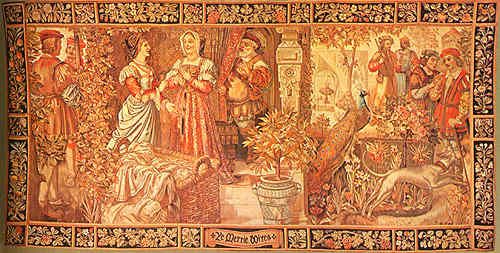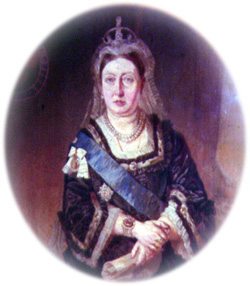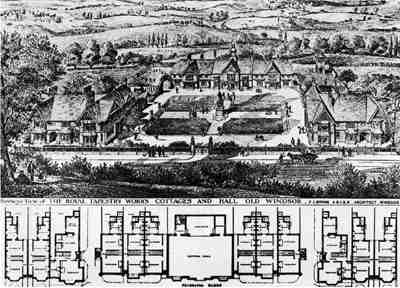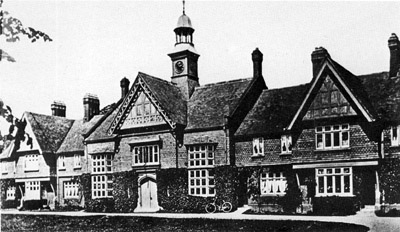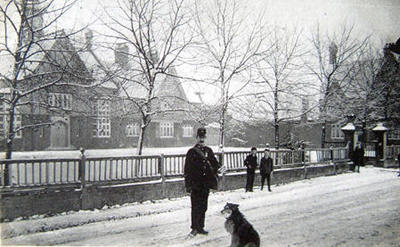|
The Tapestry Manufactory began with four low warp looms,
by 1882 there were eight looms and at the closure in 1890 there
were sixteen. One high warp loom was purchased for experimental
purposes, and for comparison of work. It appears to be significant
that American tapestry works established in 1893 after the Windsor
works had closed were all low warp, thus following the trend
established at Old Windsor and no doubt taken to the United States
by the same weavers either direct or from Aubusson. It is known
that one of the first families of weavers to go to America, the
Foussadiers, took with them a small portable low warp loom. This
was perhaps the walnut one used to demonstrate the technique
in the Guildhall at Windsor during the exhibition of Windsor
tapestries in December 1878, where it was used to weave the panel
presented to the Borough by Henri C. J. Henry.
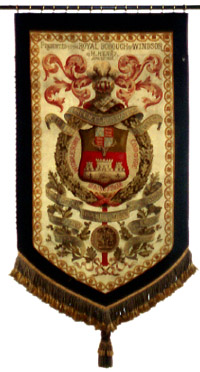
One of a pair of
Commemorative Banners presented by Mr H Henry to the Corporation
of Windsor on June 20th 1887.
Designs for the Tapestries
The notable Victorian historical
artist, E. M. Ward R.A., who lived nearby in the Borough of Windsor
and who was a friend of several members of the Royal family,
was one of the first artists engaged to prepare designs and cartoons
for the new Windsor Tapestry Manufactory. Between 1876 and his
death in 1879 he produced several designs for tapestries for
the staircase of the eccentric Christopher Sykes M.P., whose
new mansion in Hill Street, Mayfair, was where he entertained
the Prince of Wales, later to become King Edward VII. These pieces
were of hunting scenes in medieval times. Ward also designed
the huge 'Battle of Aylesford' tapestry - the largest ever made
at the Windsor works. His widow, Mrs. Henrietta Ward, worked
on several cartoons after his death.
In 1877 the first major series of tapestries - the eight panels
of the 'Merry Wives of Windsor' designed by T. W. Hay (an associate
of Henry's at Gillows) - were ordered by Gillows for the decoration
of the Prince of Wales Pavilion at the 1878 Paris Exhibition.
Here they hung in the dining room. They were very good - good
enough to win the Gold Medal for tapestries against the competition
of the great French manufacturies, a remarkable effort for a
new works. During the research for The Royal Windsor Tapestry
Manufactory in 1979, these tapestries could not be traced, but
just as the original printed version of this history was going
to press, seven of the eight came to Messrs. Christie for auction
and with their kind permission could be examined and photographed.
In addition, there have survived sketches for the 'Merry Wives
of Windsor' together with the mantlepiece they flanked, which
contained the tapestry portrait of the Queen illustrated above.
This mantlepiece, inlaid with ebony and ivory and richly carved,
and the gold medal tapestries, were subsequently bought by the
millionaire Sir Albert Sassoon for his mansion at 25 Kensington
Gore, where the Prince of Wales was a frequent guest.
Few of the original designs or cartoons are known to have survived.
Of the four cartoons for the historic Royal Windsor tapestries
in the Mansion House, three were destroyed in the 1941 blitz
on London. Several of the cartoons for the 'Royal Residence'
series of tapestries which hung above the Exit stairs from the
State Apartments at Windsor Castle are listed in the Catalogue
of Prints and Drawings at the Victoria and Albert Museum, but
do not now seem to be there. The pair of cartoons for Queen Victoria's sofa, also listed, are still safe,
as is the cartoon for Prince Leopold's
Arms. It is possible
that the sofa survives in the royal collection but the tapestry
for Prince Leopold's Arms is one of many that cannot be traced.
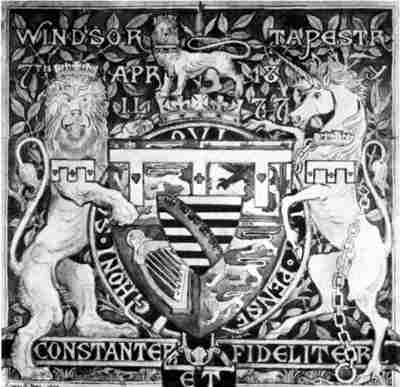 Prince Leopold's
Arms
Prince Leopold's
Arms
Chalk designs by Richard Beavis and E. M. Ward for the horses
and figures in Ward's huge 'Battle of Aylesford' tapestry are
on loan to the museum at the Guildhall, Windsor, from the Maidstone
Museum, together with the watercolours for this work and the
one by J. E. Hodgson R.A. for his 'Men of Kent marching in front
of Harold's Army'.
The Manufacture of the
Tapestries
The wool was obtained in
the natural colour, and dyed in copper vats to match exactly
the colours in the cartoons. The vats at Old Windsor were first
established by Brignolas in an outhouse at the 'Lord Nelson'
public house and soon moved to Manor Lodge, Straight Road, Old
Windsor. Outhouse and Lodge are now both demolished. The latter
site adjoins the still existing Manor Cottage and has associations
with both the Tapestry Works and the Royal Windsor Stained Glass
Works which was contemporary with the tapestry manufactory, but
under separate management.
Thousands of shades were prepared, and by twisting lighter or
darker shades of wool in one or two of the three strands, a range
of colours could be obtained to match the slightest change of
tint. Vegetable dyes were used, aniline dyes apparently being
spurned by the dyers, and these dyes with their mordants were
the responsibility of the Head Dyer, first Brignolas, then Jean
Foussadier. Foussadier apparently found the Old Windsor water
just as peculiarly suitable for dyeing as that of the Bievre
at the Gobelins in the parish of Saint Marcel near Paris. Later
he was to find the waters of the Bronx River in New York just
as suitable, 'by reason of the dissolved vegetable content'.
Here he taught all he knew to his younger son Louis, who was
to succeed his father as manager in New York, 32 years after
his arrival and apprenticeship there.
The traditional natural dyes were no doubt used, those that had
proved resistant to light. Indigo had replaced woad for blue;
a warm red came from madder and red also came from dried insects
known as Kermes, and from cochineal and Brazilwood. Purples were
made from the orchilis lichen, and the various mordants available
together with blending, gave a wide range of colours.
Shading and hatching (hachures) were used to convey three dimensional
form, folds in draperies and even skin tones and contours, together
with subtle blends of colours and highlights. In 1877 Brignolas
recorded that 5,000 shades had been produced for the work in
progress which included the Queen's portrait, and 'The Merry
Wives of Windsor'.
Brignolas was enthusiastic about the range of colours - the Circle
Chromatique - that had been developed by M. Chevreuil, who was
in charge of the dyeing laboratory at the Gobelins. This was
because of the possibilities for imitatating painting, but in
the opinion of many, including William Morris, this set the art
on a fatal course, and depreciated the tapestries' artistic integrity.
However, the portrait of Queen Victoria had very many admirers,
even Ward, who agreed with Lord Ronald Gower that 'it was faithful
to the original, and with perhaps a little more life... '
Changes of colour break the interlacing of the weft, and if continued
for several rows, becomes a slit. These, unless very small, have
to be sewn up after removal from the loom. The interlocking of
wefts obviated slits, but slits were sometimes required to indicate
a definite division, or shadow. Texture was given by 'packing'
or building up the wefts and by eccentric weaving. Slits were
sewn up by Mme. Foussadier and her daughter, Mlle. Adrienne.
The Windsor looms were 'basse-lisse', horizontal or 'low-warp',
and not 'haute-lisse', upright or 'high-warp', as at the Gobelins.
The weavers sat at the low-warp looms - as many as there were
room for having regard to the design and urgency. The operation
of the pedals enabled the bobbins loaded with coloured thread
to be passed in alternate directions. A supplement dated 29 April
1882 to the Illustrated London News contains a page of sketches
of work in progress
at the Royal Windsor Tapestry Manufactory: 'Dyeing the wool,'
'Winding the wool', A low-warp Tapestry loom, Preparing the warp,
plus an illustration of several women engaged upon repairing
old tapestry. Mme. Foussadier and her daughter Adrienne were
the chief needleworkers and repairers at Windsor and, after 1893,
in New York.
The repair of old tapestries is one of the important jobs that
comes to a tapestry works, and is extremely skilled. Queen Victoria
ordered that tapestries from Holyrood House should be sent to
Windsor for repair at the works, as were tapestries from Inverary
Castle sent in 1877 after a disastrous fire. After a similar
fire in 1975 the same tapestries were sent to nearby Hampton
Court for repair. The Irish House of Lords' tapestries were also
sent to Old Windsor for repair in 1878 and it is ironical that
when such work was desperately needed to keep the work force
employed in 1885, especially those women with parents to support,
excuses were found to deny the order to Old Windsor for repairing
some Hampton Court tapestries. Instead it was decided to employ
darning women unused to tapestry repairwork, rather than give
the struggling Royal Windsor tapestry works the chance to earn
some money. The Queen's wish that the work should be given to
Old Windsor was ignored, and the workers' expertise in repair
was denigrated. This was not the first time that the project
had met opposition - the 'trade' aspect together with the financial
uncertainty of which may have been unpopular in certain high
places.
When work was waiting and orders plentiful, many weavers came
to Old Windsor attracted by the good wages - 10 old pennies an
hour, £1 for 24 hours' work. In 1877 power-loom weavers
were getting only 87pennies. Before decimalisation in the UK
the pound sterling comprised 240 pennies. There were 12 pennies
in a shilling (5p), and twenty shillings in a pound. Spinners
received £1.69 per week according to Mr. Roy Assersohn,
the City Editor of the Daily Express in its 23 December 1977
issue. The working day at the Windsor Tapestry Manufactory commenced
at 8a.m. and finished at 6.30p.m. Most of the workers lived in
the village, providing for themselves. Eventually there were
100 households attached to the Manufactory and as many collections
of household furniture. Apparently the household effects were
found by the Manufactory, so that there were 100 sets for disposal
at the closing down sale by auction in 1895.
The weavers taught English apprentices, but there were French
apprentices such as Jean Foussadier's eldest son Antoine, who
had earned the designation of weaver by the time the Old Windsor
works had closed. Foussadier Census entry. He is on record as having worked on several important
tapestries including the Aldenham Tapestries by Herbert Bone.
Some apprentices went to the Merton Abbey tapestry works started
by William Morris. These included William Haines and William
Eleman. Both were highly regarded there and given important work.
Another weaver from Old Windsor - Octave Dennaud Bouret - was
to find employment at the Edgwater Tapestry Looms (1913-1932/3)
founded in the New Jersey town by Lorentz Kleiser. Later he went
with Kleiser to Palos Verdes and Hawthorne, California, in the
1930s in an attempt to continue the tapestry enterprise, then
suffering in the Depression.
Other weavers whose names are known include J. Roby, J. Brunaud
and J. Bregere. These three also worked on the Royal Windsor
tapestries for Aldenham House, Herts. Another worker named Francellon
had a young daughter Antoinette who at the age of three was to
present Prince Leopold's bride with a bouquet as the wedding
coach stopped briefly at the works on its way to Claremont in
April 1882.
Politics and weaving have never been far apart. English wool
played an important part in the social and economic history of
the Middle Ages, when cloth from English wool woven in the cloth
towns of Flanders supplied the traders of Europe. Edward III
made great efforts to establish the manufacture of woollen textiles
in England using wool denied to Flanders. He was aided in this
by the repression and persecution of the Flanders workers which
resulted in their coming to England where conditions appeared
to be better.
Similarly in the revolutionary days of the Commune, French tapestry
workers were attracted in 1876 to the newly set up looms of Windsor.
Michel Brignolas was an emigre who had fled from the Commune
and he probably was instrumental in inviting other experienced
workers to make the journey from Aubusson, France, to Windsor - more
than 500 miles - but the pay and conditions were better than in
France.
In February 1877 there were six workers engaged in weaving new
tapestry and repairing old at Manor Lodge. This was a small two-storey
building opposite the present 'Tapestries' or Tapestry Hall.
The latter was built in 1882 to house the expanding manufactory
and included twelve cottages for employees. A large central hall
was provided with a gallery for the display of finished tapestries.
The site for this building was leased with difficulty after long
delays from the Crown, possibly only after pressure by the Queen
and after the success at the 1878 Paris Exhibition. There had
been considerable obstruction by some at Court, who appeared
to fear a large satanic mill would develop, with smoke and noise
to distress the Castle. Prince Leopold's interest in the project
was deprecated and the Queen's support nullified for a long period.
In 1828 Windsor's first gasworks had been proposed to be erected
at 'The Nelson' public house, Old Windsor, fronting the road
to Frogmore and Windsor Castle, and this precipitated a policy
of Crown land purchase.
By 1878 there were eight looms and this number had increased
to sixteen by 1884, the same number as at the closure in 1890.
Recalling that there had been 100 households attached to the
manufactory, this amounted to a remarkable total in a village
then of about 1,100 inhabitants but nothing of the French influence
appears to remain, only a faint memory.
Events after The Death
of Prince Leopold
The sudden death of Prince
Leopold on 28 March, 1884, was a great blow to the manufactory.
The Prince had been aware of the difficulties ahead when he drafted
a letter on 21 February 1884. It was designed to enlist the sympathy
and help of Corporations and other public bodies in an effort
to establish a national enterprise connected with the Art Industry,
with aims for training and employment. He was succeeded as President
by his brother, the Prince of Wales, who circulated a similar
letter dated 22 May 1884 expressing a desire to second the efforts
made by Prince Leopold, and inviting donations towards the Endowment
Fund, orders for tapestries, and for the repair of old tapestries.
Resulting donations appear to have been few and the only order
of note was from the City of London for four historical tapestries
which now hang in the Mansion House. An order for the repair
of tapestries from Hampton Court Palace was actively opposed,
because the financial position of the manufactory was giving
cause for alarm, and, very reasonably, for the Prince of Wales
to be seen as the President of a bankrupt manufactory could not
be viewed with anything but alarm by many.
Largely due, however, to persistent efforts by the Secretary,
Sir Robert Collins and by Princess Helen, Duchess of Albany (the
widow of Prince Leopold) and to the sympathy of Queen Victoria,
the manufactory was saved from immediate closure. Control was
vested in the hands of the Guarantors who had put their money
into the project and they decided to continue operations in the
face of opposition from many at court. The Guarantors still had
some hope of getting their money back when the stocks had been
sold, particularly if new orders could be obtained. The Gibbs
family ordered two groups of historical tapestries, 'The Windsor
Tapestries at Tyntesfield Somerset' and the 'Windsor Tapestries
at Aldenham House Hertfordshire', which were described in detail
by the designer Herbert Bone in privately printed pamphlets dated
1888 and 1881 respectively. The reputation of the Manufactory
gained much from these magnificent tapestries according to contemporary
reports but only the former have been traced and seen by the
writer, although the latter group may exist still - they
passed through the London auction salerooms in the 1930s.
After these orders and a few others had been completed, the decline
of the Windsor Manufactory could not be arrested. Henri C. J.
Henry made great efforts in 1888 to secure an order from the
Drapers Company for a copy of 'Jason and Medea', the 18th century
Gobelin tapestry in the Grand Reception Room at Windsor Castle.
The order seemed imminent and consent to make the copy had been
received, when the Drapers changed their minds. Whether the works
at Old Windsor had appeared run down when visited by the Company's
representatives (certainly many workers had drifted back to France
by then) or whether pressure had been exerted is not known. The
long hoped for help from the Government in the form of the creation
of a National Establishment (as in France) to make and repair
fine tapestries for the nation's public buildings was not to
become fact and after more than twelve years all those concerned
must have lost heart. The £1,000 or so a year grant for
'The Arts' that had stopped because of Government economies after
the Prince Consort died was not to be recommended but it was
dourly noted by the Guarantors that large sums were spent on
buying foreign 'works of art' to embellish Government buildings.
Some newspaper reviews of the fine tapestries, while praising
their artistry and quality referred to their alleged unhygienic
properties. A series of bad harvests in the late 1870s followed
by a huge increase in food imports including prairie wheat and
New Zealand frozen mutton spelt ruin for British agriculture
and less money for the great landowners whose orders might have
kept the works open. By September 1888 the last French weaver,
except for Brignolas, had returned to Aubusson. Some were to
be persuaded to go
to New York, as did the Foussadier family of five, apparently
direct from Aubusson early in 1893. William Baumgarten's inducements
of good wages and steady employment had won their favour and
the first American tapestry works was to start by the Bronx river.
Brignolas moved to Poland Street, Soho, where he set up his workshop.
Among his works there is a series depicting the history of the
Clan Macintosh.
The Old Windsor Manufactory closed its doors on Christmas Eve
1890. The plant was sold by auction in March 1895. It included
sixteen looms, three spinning wheels, a French billiards table,
100 lots of household furniture and the magnificent cartoons
by British artists including E. M. Ward R.A. Almost all of these
were bought by manufacturers from Aubusson for ridiculously low
prices - 'hardly more than the value of the paper canvas and
string' reported the press. Some 'false' Royal Windsor tapestries
were to come on to the market, giving the Manufactory a bad name
but whether or not these came from Aubusson is not known. They
look like 'RWTs', but have no marks.
Exhibitions and Collections
The fame of the Royal Windsor
Tapestry Manufactory may be traceable to an Exposition promoted
in the Golden Gate Park, San Francisco in 1894 by M. H. de Young
who is known to have been impressed by the World's Columbian
Exposition of 1893 in Chicago, and it was to the Chicago Fair
of 1893 that Walter Henry Harris of the City of London, British
Commissioner to the Fair, took a collection of 31 Royal Windsor
Tapestries. He had them photographed in 'platinotype' and the
prints bound together with a preface outlining the history of
the Manufactory in four copies. He was permitted to present the
first of these to Queen Victoria at Balmoral, the second to the
Duchess of Albany and the third to the Prince of Wales. The last
copy appears to be lost, but the other two are in the Royal Collection
and Princess Alice's residence at Kensington Palace respectively,
while the fourth is in the Reading Reference Library.
The San Francisco Exposition of 1894 left a dollar surplus and
the exhibited items. The latter became the nucleus of the M.
H. de Young Memorial Museum at Golden Gate Park, San Francisco,
and also contributed to the equally magnificent California Palace
of the Legion of Honor at Lincoln Park. The collection of tapestries
augmented by gifts from the Hearst Foundation and other important
gifts and purchases has resulted in a concentration of famous
tapestries probably unrivalled anywhere in the world, as demonstrated
by their 'Five Centuries of Tapestry' exhibition of 1976.
The RWTM Weavers Mark
Royal Windsor Tapestries
may be identified by the weaver's mark, which is a stylized crown
above two capital 'L', the first reversed.
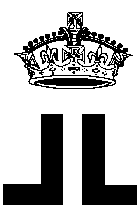 The Royal Windsor
Tapestry weavers mark
The Royal Windsor
Tapestry weavers mark
N.B. For
simplicity in these pages '
_l l_ ' has been used in the accompanying text pages
This is usually found on
the top guard edge, sometimes with 'Royal Windsor Tapestry' woven
in block letters about one inch in height. In the early tapestries,
the weavers' marks were superimposed on the design, near the
bottom, as in 'The Merry Wives of Windsor' series.
When King Edward came to deal with the personal possessions left
at Windsor Castle by Queen Victoria, it appears that tapestries
which had been rolled up and forgotten were among other things
disposed of or destroyed.
No details have survived concerning the complete output of the
manufactory, but the items on this web site comprise almost every
item found to date and is sufficient perhaps to indicate the
importance of the Old Windsor tapestries: the only attempt other
than that of William Morris to revive this ancient craft in England
in the 19th century.
Index to the
Tapestries
The Royal
Windsor History Zone
The Royal
Windsor Home Page
ALSO SEE (External
Link)
Tapestries Direct
More about the History of Tapestry
 To contact us,
email Thamesweb.
To contact us,
email Thamesweb.
|


